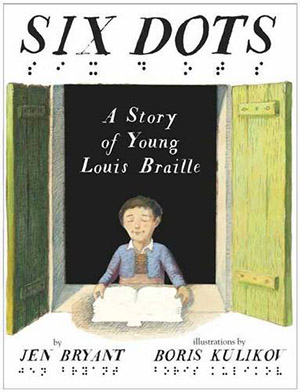Six Dots is a delightful surprise and curiosity-generating story. I really honestly had not thought about who Louis Braille was beyond obviously being the person behind the Braille language. That said, Jen Bryant did an excellent job researching the facts of young Louis Braille, the time period, and then filling in the blanks with literary details and adding illustrations by Boris Kulikov, to make the story personal and inspiring.
[alert variation=”alert-info”]Publisher: Knopf Books for Young Readers
Formats: Hardcover, eBook, Kindle
Purchase: Powell’s | Amazon | IndieBound | iBooks[/alert]
This story highlights Louis as an eager learner with a heart bigger than his five-year-old self. What you probably didn’t know that Louis Braille lost his vision at five due to an accident. Louis could have taken the woe-is me path, but instead, he kept looking for books that did not exist, so he could read as a young blind boy. Even when at the Blind School, which I am sure was much more dreary and miserable than the author describes, he wants to read more and does not accept the current standard as enough. Inspired by a wartime encryption method as a tween, he goes on as a teenager to perfect the six-dot Braille system used today.
The creators of this book present an accurate version of his young life that connects with its readers. I always love when books inspire one (myself included) to want to go and learn more about a topic or person. This book will certainly generate more curiosity in Louis Braille and the language system. The inside back of the book does present the Braille alphabet in picture but not a tactile version. I really hope that there is a Braille version for young readers, sighted or not, out there. The book itself is geared more towards maybe a 6-9 year olds to start as the story has more words than your average toddler could sit through. However, even older children may enjoy reading the story. It could make for a fun ‘first book club’ book given the thoughtful author question and answer section at the end, complete with resources to go and learn more.
I absolutely recommend this book and would encourage elementary school teachers to also include it in their classrooms, maybe for a Blind Awareness Month (October) or Braille Literacy Month (January) or National Reading Month (March) or, ok, you get it, an anytime project!
[signoff predefined=”Social Media Reminder” icon=”facebook”][/signoff]

